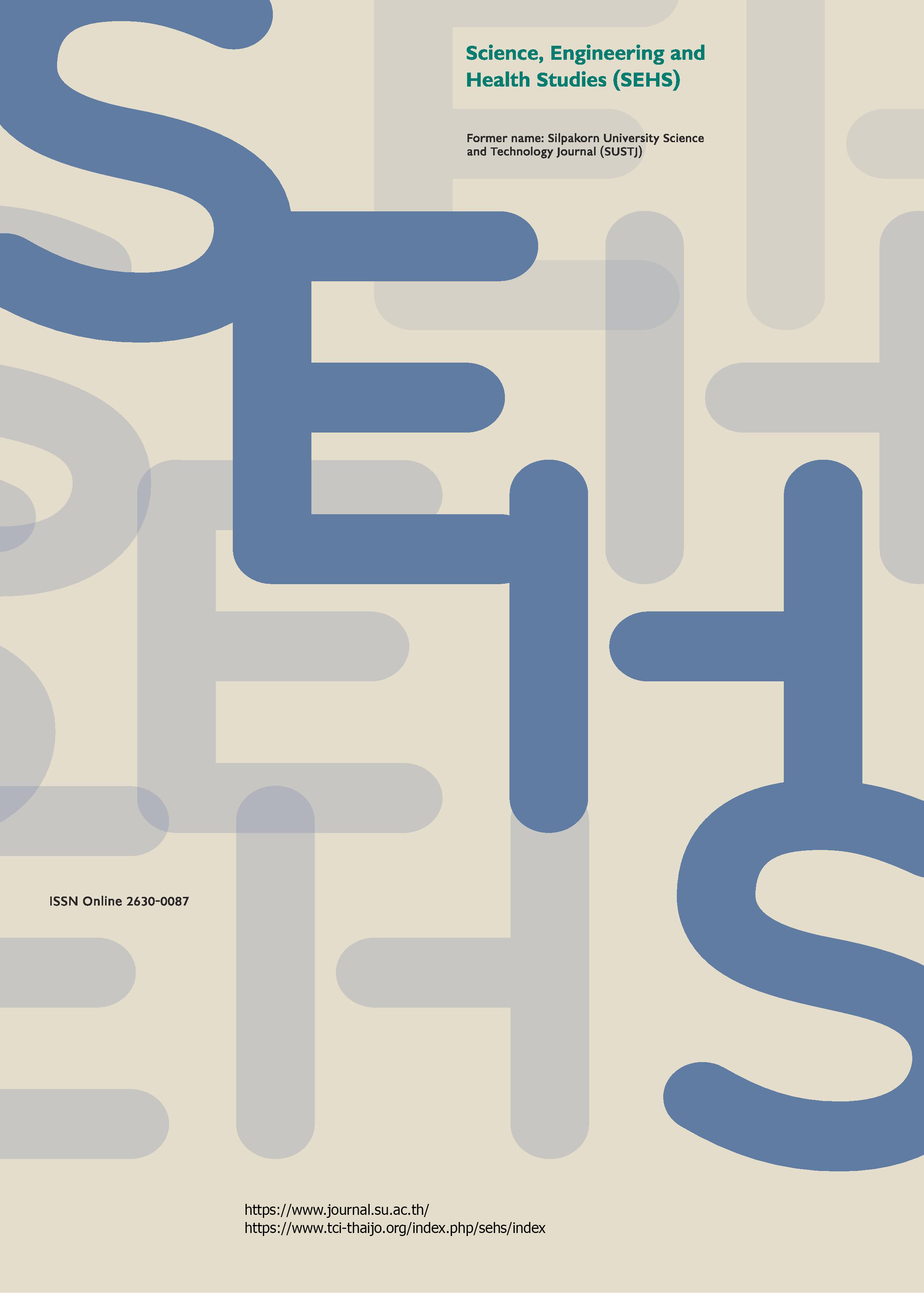Advancing pharmaceutical sciences: Highlights from PST 2024 – Bridging innovation, technology, and sustainability
Main Article Content
Abstract
EDITORIAL
The 7th International Conference and Exhibition on Pharmaceutical Science and Technology (PST 2024) served as an exceptional platform for showcasing cutting-edge advancements in pharmaceutical science and technology. Held in the scenic city of Chiang Mai, Thailand, and themed “Global PharmaConnect: Integrating Sciences, Technology, and Industry for a Future Sustainable Innovation,” the conference brought together innovative research addressing critical challenges in the pharmaceutical and healthcare sectors. This editorial highlights seven selected studies presented at the event, reflecting the diversity and ingenuity of the conference’s contributions.
Kriangkrai et al. (2024) introduced advancements in effervescent floating systems by leveraging multi-layer coating techniques to enhance buoyancy and control drug release. Their novel tablet design, featuring core effervescent and gas-entrapped layers, achieved rapid floating within 1.25 min while maintaining buoyancy for over 8 h. By varying the number of spray-coating layers, the researchers fine-tuned drug release profiles, achieving zero-order and Higuchi release kinetics. This innovation provides a practical solution for gastro-retentive drug delivery, ensuring prolonged drug availability in the gastrointestinal tract.
Burapapadh et al. (2024) addressed the challenge of masking the bitterness of diclofenac sodium in pediatric and geriatric formulations by developing taste-masked enteric granules using Eudragit® E PO. The optimized granules effectively masked drug’s taste while maintaining its controlled release properties in gastrointestinal environments. The polymer ratio of 1:0.25 was found to be the most effective, offering a patient-friendly solution with minimal impact on the drug’s release profile, ensuring therapeutic efficacy and patient compliance.
Chamsai et al. (2024) tackled the challenge of oral administration of isophane insulin, which suffers from instability in the gastrointestinal environment, by developing nanoparticles using hydroxypropyl β-cyclodextrin-insulin complexes encapsulated within thiolated chitosan and sodium alginate. Using a full factorial design, the researchers optimized the nanoparticles to achieve small particle sizes and zeta potentials within the desirable range of +30 mV to +50 mV, ensuring both stability and efficient encapsulation. Spherical particles confirmed by transmission electron microscopic imaging demonstrated the successful incorporation of insulin, with the optimized formulation offering a promising platform for oral insulin delivery.
Sobharaksha et al. (2024) investigated the potential of liquid crystal emulsions for delivering mangiferin, a natural antioxidant and anti-inflammatory compound. The emulsions, prepared using sorbitan palmitate and sucrose palmitate, displayed the characteristic Maltese cross pattern under polarized light microscopy, confirming their liquid crystal structure. Stability studies revealed that while mangiferin content decreased slightly over 90 days, its antioxidant activity remained intact. The emulsions improved skin hydration and reduced transepidermal water loss without causing irritation, highlighting their potential for cosmetic applications aimed at enhancing skin health.
Sisavengsouk et al. (2024) developed a stable topical delivery system for lutein, a carotenoid with potent antioxidant properties but poor stability under environmental conditions. Using Span® 20, cholesterol, and oleic acid, the researchers formulated lutein-loaded niosomes via the thin-film hydration method. The inclusion of limonene as a skin penetration enhancer further improved lutein’s delivery into the skin. The niosomes exhibited strong antioxidant activity and superior stability compared to unencapsulated lutein, positioning this formulation as a promising candidate for cosmeceutical applications to combat oxidative skin damage.
The antioxidant potential of gallic acid-derived carbon-based nanomaterials synthesized using a microwave-assisted pyrolysis method was explored by Dechsri et al. (2024). The resulting nanomaterials displayed a spherical morphology with a particle size of 104.43 nm and a significantly higher reactive oxygen species scavenging ability than gallic acid alone, with a 50% scavenging capacity of 0.99 μg/mL. Additionally, the carbon-based nanomaterials were non-toxic to human fibroblast cells, emphasizing their biocompatibility and potential as powerful antioxidants for skincare and biomedical applications.
Thipunkaew et al. (2024) developed and validated a semi-automated TLC-densitometry method for quantifying 1'-acetoxychavicol acetate (ACA), a biologically active compound extracted from Alpinia galanga. The method demonstrated exceptional precision, with recovery rates exceeding 94%, and was successfully applied to green solvent extracts, including soft extracts and glycerol liquid extracts. This validated method provides a robust tool for quantifying ACA in natural product formulations, enabling its use in cosmetics and topical pharmaceuticals.
These research represent the inventive spirit and scientific rigor demonstrated at PST 2024, providing answers to major pharmaceutical and healthcare concerns. The research presented, ranging from drug delivery technologies to innovative materials and cosmeceuticals, demonstrates pharmaceutical science's transformational potential in improving global health outcomes. The conference's success reflects the effort and teamwork of scholars, reviewers, and organizers, setting the path for future developments in the discipline.
Downloads
Article Details

This work is licensed under a Creative Commons Attribution-NonCommercial-NoDerivatives 4.0 International License.
References
Burapapadh, K., Warintaksa, P., Ruksapram, S., and Saokham, P. (2024). Development of taste-masked enteric granules containing diclofenac sodium utilizing Eudragit® E PO as a taste-masking agent. Science, Engineering and Health Studies, 18, 24050016.
Chamsai, B., Opanasopit, P., and Samprasit, W. (2024). Optimization of hydroxypropyl β-cyclodextrin-isophane insulin complex-loaded thiolated chitosan/sodium alginate nanoparticles using full factorial design. Science, Engineering and Health Studies, 18, 24050011.
Dechsri, K., Suwanchawalit, C., Pengnam, S., Pornpitchanarong, C., Opanasopit, P., and Apirakaramwong, A. (2024). Antioxidant activity of gallic acid carbon-based nanomaterials. Science, Engineering and Health Studies, 18, 24050019.
Kriangkrai, W., Athiya, A., Thepphantha, A., Sungthongjeen, S. (2024). Advancing effervescent floating systems: Leveraging multi-layer coatings for enhanced buoyancy and controlled drug release. Science, Engineering and Health Studies, 18, 24050021.
Sisavengsouk, S., Charoenying, T., Opanasopit, P., and Pengnam, S. (2024). Development of lutein-loaded niosomes for topical delivery. Science, Engineering and Health Studies, 18, 24050026.
Sobharaksha, P., Mahamongkol, H., Channarong, S., Tansathien, K., and Wongtrakul, P. (2024). Development of mangiferin-loaded anisotropic emulsion for cosmetic applications: A comprehensive study on formulation, antioxidant activity, stability, and skin compatibility. Science, Engineering and Health Studies, 18, 24050022.
Thipunkaew, N., Chaivichacharn, P., Chanachai, P., Wongtrakul, P., and Channarong, S. (2024). Development and validation of TLC-densitometry method for quantitation of 1′-acetoxychavicol acetate in Alpinia galanga (L.) Willd. rhizome green solvent extracts. Science, Engineering and Health Studies, 18, 24050024.

